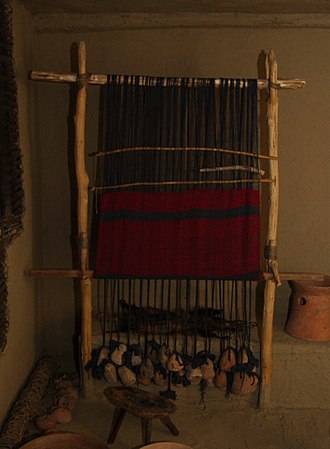
The warp-weighted loom is a simple and ancient form of loom in which the warp yarns hang freely from a bar, which is supported by upright poles which can be placed at a convenient slant against a wall. Bundles of warp threads are tied to hanging weights called loom weights which keep the threads taut. [1]
Contents
Evidence of the warp-weighted loom appears in the Neolithic period in central Europe. It is depicted in artifacts of Bronze Age in Greece. Loom weights from the Bronze Age were excavated in Miletos, a Greek city in Anatolia. [2] The warp-weighted looms were common throughout Europe, remaining in use in some areas of Scandinavia into the modern era.
In Sápmi, the warp-weighted loom is a living cultural heritage today, particularly in use for weaving of traditional blankets among the Sea Sami. [3]
The warp tension needed on a loom is roughly proportional to yarn diameter, and loom weights must be positioned in an even, level row, with all the threads hanging nearly straight down, for smooth weaving. This means that the shape of a loom weight limits a loom to certain thread counts, and the mass of the loom weight is related to the yarn used. This means that loom weights can be used to calculate the density and other properties of the fabric made on them. [4]












